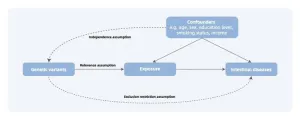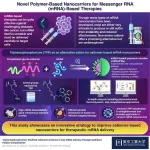(Press-News.org) USC scientists have discovered a way to turn the body’s B cells into tiny surveillance machines and antibody factories that can pump out specially designed antibodies to destroy cancer cells or HIV, two of medicine’s most formidable foes.
The research, published today in Nature Biomedical Engineering, describes a technique for editing the genes of immune cells called B cells, turbocharging them to fight even the sneakiest invaders. The work is an important advance in harnessing the power of antibodies to treat conditions ranging from Alzheimer’s disease to arthritis.
“In some diseases or conditions, the natural antibodies made by B cells are just not good enough,” said senior author Paula Cannon, a Distinguished Professor of Molecular Microbiology & Immunology at the Keck School of Medicine of USC. “HIV is a very good example of that. It mutates constantly, keeping one step ahead of whichever antibodies are being thrown at it. We thought a checkmate move might be persuading B cells to make an antibody that was so broad in its ability to ‘see’ HIV that HIV couldn’t easily mutate around it.”
The beauty of the technique, the researchers said, is it can be adapted to produce a broad range of different antibodies.
“It’s a technology for reprogramming B cells that could be applied to almost anything you can imagine dealing with an antibody,” said first author Geoffrey Rogers, a research associate and senior postdoctoral fellow in Cannon’s lab. “We think we’ll be able to completely customize everything about the antibody.”
For this project, the researchers took inspiration from chimeric antigen receptor (CAR) T cells, “living drugs” designed to target specific things. They’ve revolutionized treatment for blood cancers like leukemia and lymphoma. With CAR T treatment, T cells — sister cells to B cells — are removed from a patient’s blood and genetically modified to identify cancer cells by recognizing a marker on their surface. Millions of the cells are then infused into the patient’s body, where they fight disease and then fade away.
B cells behave differently, making them more suitable for fighting chronic conditions. They function as both a security system and antibody factory, residing long-term in the bone marrow, lymph nodes and spleen — and firing up when needed.
To make these tiny fighters, Cannon and Rogers used CRISPR gene editing methods to place the instructions for custom antibodies at the exact site in the B cell’s DNA where antibodies are naturally made. This trick means that B cells can be reprogrammed as biofactories making the custom antibodies. And just as regular antibodies respond to vaccination, the reprogrammed B cells could also be stimulated to increase their output.
Researchers were able to observe the antibodies at work using tonsil tissue to replicate an immune system in a dish.
The researchers are working with the USC Stevens Center for Innovation to license the technology for commercial use. The USC Stevens Center helps scientists shepherd their discoveries from the lab to the market.
“We’re really excited to help try and bring this to biotech companies,” said Erin Overstreet, executive director of the USC Stevens Center. “This could be a fundamental shift in how we approach certain diseases.”
In addition to Cannon and Rogers, other authors of the paper are Chun Huang, Atishay Mathur, Xiaoli Huang, Hsu-Yu Chen, Kalya Stanten, Heidy Morales, Chan-Hua Chang and Eric Kezirian, all of USC.
The work was supported with grants from the National Institutes of Health (HL156274, AI164561, AI164556 and MH130178).
# # #
END
B cell biohack: USC engineers immune cells to churn out custom antibodies
“We think we’ll be able to completely customize everything about the antibody.”
2024-07-22
ELSE PRESS RELEASES FROM THIS DATE:
Understanding how a red seaweed reduces methane emissions from cows
2024-07-22
Methane is the second-largest contributor to climate warming after carbon dioxide, and so scientists have put a lot of attention toward addressing one of the top sources: methane emissions from livestock. In other words, cow burps are bad for the planet.
Farmers add various seaweeds to cow diets as a source of protein, unsaturated fats, and other health-promoting ingredients that provide immediate energy, says Dipti Pitta of the University of Pennsylvania School of Veterinary Medicine, and a 2016 study in Australia found that feeding sheep a species ...
Genome study informs restoration of American chestnut tree
2024-07-22
Native trees adapt to the climate and environmental conditions of their area to survive. Researchers in the College of Natural Resources and Environment in collaboration with the American Chestnut Foundation confirmed this by examining the genome of American chestnut trees sampled throughout the Appalachian Mountain range and grouping the samples according to their specific environmental region.
The research, recently published in the Proceedings of the National Academy of Sciences journal, has the potential to help the ...
Improved efficacy of pembrolizumab when combined with sEphB4-HSA in HPV-negative EphrinB2-positive HNSCC
2024-07-22
“Future development for sEphB4-HSA in HNSCC is likely to focus on patients with HPV-negative disease where there is greatest need to improve on the outcomes with pembrolizumab monotherapy.”
BUFFALO, NY- July 22, 2024 – A new research paper was published in Oncotarget's Volume 15 on July 10, 2024, entitled, “Improved efficacy of pembrolizumab combined with soluble EphB4-albumin in HPV-negative EphrinB2 positive head neck squamous cell carcinoma.”
Patients with relapsed or metastatic head and neck squamous cell carcinoma (HNSCC) after primary local ...
Sleep and social media in tweens: Tips for better rest
2024-07-22
Toronto, ON - The US Surgeon General recently recommended a warning label for social media platforms due to concerns about their impact on youth mental health. The Surgeon General’s Advisory on Social Media and Youth Mental Health highlighted potential links between social media use and poor sleep quality in youth. Considering these concerns, what specific actions can adolescents and parents take to improve sleep?
A new national study, published in the Journal of Adolescent Health, offers insights into screen habits linked with better sleep.
“Ensuring adolescents get enough sleep is vital, as it supports ...
Effect of cash benefits on health care utilization and health
2024-07-22
About The Study: In this randomized study, individuals who received a cash benefit had significantly fewer emergency department visits, including those related to behavioral health and substance use, fewer admissions to the hospital from the emergency department, and increased use of outpatient subspecialty care. Study results suggest that policies that seek to alleviate poverty by providing income support may have important benefits for health and access to care.
Corresponding Author: To contact the corresponding author, Sumit D. Agarwal, M.D., M.P.H., Ph.D., email sagarwal14@bwh.harvard.edu.
To access the embargoed study: Visit our For The Media ...
Mendelian randomization analysis for intestinal disease: Achievement and future
2024-07-22
Traditional epidemiological studies have identified numerous potential risk factors, but observational studies have struggled to establish causal links due to confounding factors and reverse causation. Theoretically avoiding confounding and reverse causation, Mendelian randomization (MR) infers causality, offering novel research perspectives and methods for investigating risk factors of intestinal diseases (Figure 1).
MR research on intestinal disease
Based on MR methodology, researchers have identified lifestyle factors, circulating nutrients, and obesity as being associated with the risk of ...
Improving the design of mRNA-loaded nanocarriers for targeted therapies
2024-07-22
Among the vastly different ways of tackling a disease, controlling the genetic expression of cells is undoubtedly one of the most powerful. Over the past few decades, scientists have come up with dozens of innovative strategies that involve using messenger RNA (mRNA) to ‘force’ cells to build specific proteins. These mRNA-based therapies have recently gained prominence as vaccines against infectious diseases like COVID-19. Additionally, they hold significant potential for treating cancer and genetic disorders.
Since mRNA itself is ...
Chimpanzees gesture back and forth quickly like in human conversations
2024-07-22
When people are having a conversation, they rapidly take turns speaking and sometimes even interrupt. Now, researchers who have collected the largest ever dataset of chimpanzee “conversations” have found that they communicate back and forth using gestures following the same rapid-fire pattern. The findings are reported on July 22 in the journal Current Biology.
“While human languages are incredibly diverse, a hallmark we all share is that our conversations are structured with fast-paced turns of just 200 milliseconds on average,” ...
Deep-ocean floor produces its own oxygen
2024-07-22
An international team of researchers, including a Northwestern University chemist, has discovered that metallic minerals on the deep-ocean floor produce oxygen — 13,000 feet below the surface.
The surprising discovery challenges long-held assumptions that only photosynthetic organisms, such as plants and algae, generate Earth’s oxygen. But the new finding shows there might be another way. It appears oxygen also can be produced at the seafloor — where no light can penetrate — to support the oxygen-breathing (aerobic) sea life living in complete darkness.
The ...
Prenatal cannabis use and maternal pregnancy outcomes
2024-07-22
About The Study: The results of this cohort study suggest that prenatal cannabis use was associated with several adverse maternal health outcomes during pregnancy. Continued research is needed to understand whether characteristics of prenatal cannabis use (e.g., dose, mode, and timing) moderate these associations.
Corresponding Author: To contact the corresponding author, Kelly C. Young-Wolff, Ph.D., M.P.H., email kelly.c.young-wolff@kp.org.
To access the embargoed study: Visit our For The Media ...
LAST 30 PRESS RELEASES:
The impact of family dynamics on eating behaviour – how going home for Christmas can change how you eat
Tracing the quick synthesis of an industrially important catalyst
New software sheds light on cancer’s hidden genetic networks
UT Health San Antonio awarded $3 million in CPRIT grants to bolster cancer research and prevention efforts in South Texas
Third symposium spotlights global challenge of new contaminants in China’s fight against pollution
From straw to soil harmony: International team reveals how biochar supercharges carbon-smart farming
Myeloma: How AI is redrawing the map of cancer care
Manhattan E. Charurat, Ph.D., MHS invested as the Homer and Martha Gudelsky Distinguished Professor in Medicine at the University of Maryland School of Medicine
Insilico Medicine’s Pharma.AI Q4 Winter Launch Recap: Revolutionizing drug discovery with cutting-edge AI innovations, accelerating the path to pharmaceutical superintelligence
Nanoplastics have diet-dependent impacts on digestive system health
Brain neuron death occurs throughout life and increases with age, a natural human protein drug may halt neuron death in Alzheimer’s disease
SPIE and CLP announce the recipients of the 2025 Advanced Photonics Young Innovator Award
Lessons from the Caldor Fire’s Christmas Valley ‘Miracle’
Ant societies rose by trading individual protection for collective power
Research reveals how ancient viral DNA shapes early embryonic development
A molecular gatekeeper that controls protein synthesis
New ‘cloaking device’ concept to shield sensitive tech from magnetic fields
Researchers show impact of mountain building and climate change on alpine biodiversity
Study models the transition from Neanderthals to modern humans in Europe
University of Phoenix College of Doctoral Studies releases white paper on AI-driven skilling to reduce burnout and restore worker autonomy
AIs fail at the game of visual “telephone”
The levers for a sustainable food system
Potential changes in US homelessness by ending federal support for housing first programs
Vulnerability of large language models to prompt injection when providing medical advice
Researchers develop new system for high-energy-density, long-life, multi-electron transfer bromine-based flow batteries
Ending federal support for housing first programs could increase U.S. homelessness by 5% in one year, new JAMA study finds
New research uncovers molecular ‘safety switch’ shielding cancers from immune attack
Bacteria resisting viral infection can still sink carbon to ocean floor
Younger biological age may increase depression risk in older women during COVID-19
Bharat Innovates 2026 National Basecamp Showcases India’s Most Promising Deep-Tech Ventures
[Press-News.org] B cell biohack: USC engineers immune cells to churn out custom antibodies“We think we’ll be able to completely customize everything about the antibody.”





